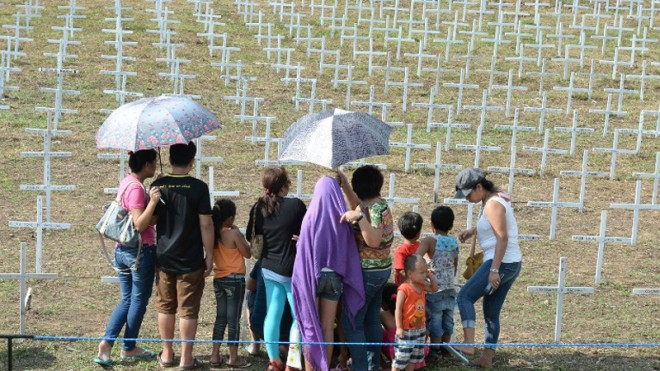Prayers, tears one year after ‘Yolanda’

Relatives of victims of ‘Yolanda’ visit the mass grave as they offer prayers for their loved ones at Vasper village in Tacloban City Friday, a day before the first year anniversary of the devastating typhoon. AFP
TACLOBAN CITY, Philippines–Survivors of the strongest typhoon ever to hit land descended on mass graves Saturday to mark one year since the storm devastated the central Philippines and condemned millions to deeper poverty.
Super Typhoon “Yolanda” (international codename: Haiyan) claimed more than 7,350 lives as it swept in off the Pacific Ocean, with its record winds and once-in-a-generation storm surges flattening entire towns.
The typhoon tore across a corridor of islands where about 14 million people lived in farming and fishing communities that were already among the nation’s poorest.
The rebuilding effort has been painfully slow for most survivors, with millions poorer and many dangerously exposed to the next big storm as they still live in shanty homes along coastal areas.
Outpouring of grief
In an outpouring of grief, tens of thousands marched to the grave sites under the hot sun on Saturday to offer flowers, light candles and say prayers.
Josephine Crisostomo’s three children died during the storm, including her youngest, who would have turned two years old on Sunday.
“I miss my children terribly, especially John Dave who would have celebrated his birthday tomorrow… I miss you, son, I love you so much,” Crisostomo, 41, said at one of the mass graves in the outskirts of badly-hit Tacloban city.
Using felt-tip pens, mourners wrote names of those who died on the hundreds of white crosses planted on parched earth in symbolic gestures as the more than 2,000 people buried there had not been identified.
“I am looking for my brother, but his name is not on the list of those buried here,” Elena Olendan, 50, told Agence France-Presse, her eyes welling with tears, as she wandered around the grave site, about the size of six basketball courts.
Olendan had not reported her 60-year-old brother, Antonio, as missing when Yolanda struck. She found a cross on the far end of the mass grave and wrote her brother’s name on it.
National day of prayer
The Philippines is a mainly Catholic country and many people in the typhoon zones, as well as across the nation, attended special church services.
The Catholic Bishops’ Conference of the Philippines declared Saturday a national day of prayer, and church bells across the nation would ring at 6 p.m. to remember those who died or suffered in the storm.
The build-up to the anniversary had focused renewed attention on the pace of the reconstruction effort, with President Benigno Aquino’s government criticized by many for a perceived lack of urgency.
Roughly one million people need to be moved away from coastal areas that are deemed vulnerable to storm surges, according to a P160-billion ($3.6-billion) government master plan for rebuilding the typhoon zones.
However those plans have already fallen behind schedule, delayed by problems in finding new land that is safe and suitable for 205,000 new homes.
‘Curse me’
In a speech at the typhoon-hit town of Guiuan on Friday, Aquino defended the pace of the reconstruction program, saying he was determined to ensure it was carried out correctly rather than rushing.
“Curse me, criticize me but I believe I must do the right thing,” Aquino said.
“I am impatient like everyone else but I have to stress that we can’t rebuild haphazardly. We have to build back better… let’s get it right the first time and the benefits should be permanent.”
Aquino also cited international aid agencies as saying post-Yolanda recovery efforts were moving faster compared with programs in Indonesia’s Banda Aceh after it was hit by mega-tsunami waves in 2004.
And while millions endure Yolanda-exacerbated poverty, there has been some remarkable progress from a year ago as international aid agencies have pumped hundreds of millions of dollars into the region.
Some of the big successes of the campaign have been the restoration of electricity within a few months, quick replanting of crops and sanitation programs that prevented major outbreaks of killer diseases.
Tacloban again resembles many other chaotic Philippine cities, with traffic jams, busy market stalls and packed shopping malls.
In the countryside, lush green paddies are testament to successful rice planting campaigns that have sustained millions.
RELATED STORY
Aquino: Curse me, criticize me but I must do right thing
Yolanda: The storm of the century
RELATED VIDEOS














